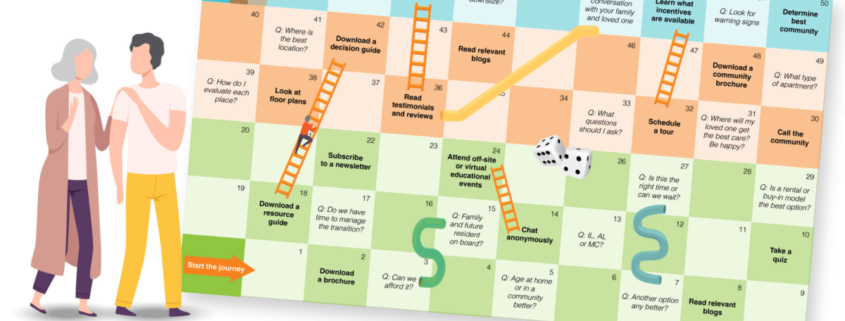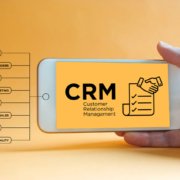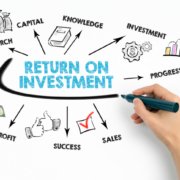The Non-Linear Customer Journey in Senior Living Marketing
When marketers discuss the prospect’s journey, they often talk about three stages: awareness, consideration, and decision. In senior living, you must also consider three other stages: whether, where, and when.
Below, we dive deeper into each stage, including how they should influence your senior living marketing efforts.
The “whether” stage
In the “whether” stage, prospects are thinking about things like whether they should consider using home care instead of moving into a community, whether they can afford senior living, whether they have to sell their home before moving in, whether they can get the family on board, and so forth.
They’ll often turn to the internet to research these questions. If they land on your website and download a resource, like a ‘home care vs. assisted living’ guide, they might gain a general awareness of your community. But awareness isn’t their goal—at least, not yet. They’re looking for answers to questions.
How the “whether” stage should influence your senior living marketing efforts:
- Develop a solid strategy for scoring and segmenting leads. Most people in this stage are not ready for a sales interaction. Instead, they should be entered into an appropriate long-term lead nurturing workflow.
- Create a deep library of engaging content. The sales cycles for independent living and assisted living are long. Prospects might require upwards of thirty “touches.” The content you offer on touch #22 must be as engaging and helpful as the content you offer on touch #1.
- Use marketing automation. Marketing automation sends the right message to the right person at the right time—an essential tool when dealing with sales cycles that last months or even years.
The “where” stage
The “where” stage coincides with the consideration stage. People in this stage are looking at senior living options. They’ve accepted—or come around to the idea, at least—that senior living is the best option for their situation.
They’re still researching—but now they’re doing it with a singular focus. Where is the best place for them to move into? They’ll have a much more critical eye when reviewing senior living websites. They’ll check out reviews, pay attention to what people say on social media, and click on targeted paid advertising.
How the “where” stage should influence your senior living marketing efforts:
- Provide compelling specifics about life in your community. The “general” content got them to your website in the first place, like the ‘assisted living vs. home care’ guide we mentioned earlier. Now, they’re eager to learn the specifics about your community, including what makes it unique. Real photos of the spaces, residents and staff, plentiful videos, and transparent pricing are all excellent ways to show your community’s unique attributes.
- Pay attention to your community’s reviews. People read reviews, full stop. Make sure you claim your profile on popular review sites for senior living. Keep your Google Business Profile updated as well. (Overwhelmed? Hint: We can manage all of this for you.)
- Embrace paid digital advertising. Pay-per-click advertising can be highly effective for senior living communities—and cost-effective to boot since you only pay when someone clicks on the ad. In particular, remarketing (those ads that follow people around online after they visit your website) can help keep your community top of mind. Native advertising on social media can also be an effective way to encourage people to return to your site.
- Invite people into your community. Ultimately, you want to get people off their computers and into your community so they can experience it first-hand. Inviting people for a complimentary lunch, a resident backyard BBQ, and other events is a great way to help people in the “where” stage envision themselves in your community.
The “when” stage
The “when” stage happens alongside the decision stage. Prospects have narrowed their choices, zeroed in on the “winner,” and are deciding when to move.
Sometimes, people are contemplating two contenders who are neck and neck—this is where your teams (marketing and sales) might need to develop other programs/collateral to help people get off the fence.
How the “when” stage should influence your senior living marketing and sales efforts:
- Offer incentives. This is the best stage to offer an incentive to create urgency—to move sooner rather than later (and to choose your community over another).
- Provide a visual. You already know who your competitors are in the area. Create a nicely designed comparison chart that highlights your community’s offerings. Your sales team could deliver it to the prospect with baked goods from the kitchen.
Bonus: Events for each stage
Check out our article about senior living marketing events for each stage. And, of course, if you need help scoring and segmenting leads—or implementing marketing automation—get in touch.












